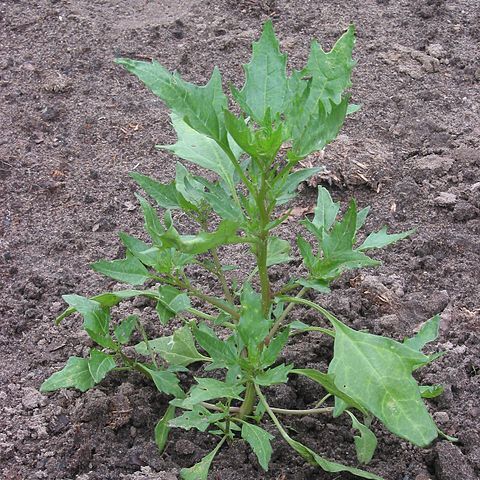Annual, branched from the base, prostrate to erect, 1–8 dm, the foliage and fls commonly tinged with red or becoming red at maturity; lvs commonly rhombic-ovate or oblong, with a conspicuous lateral tooth on each side, cuneate below the teeth, varying to entire or several-toothed, green on both sides; fls in ± numerous glomerules, these to ca 5 mm thick at maturity, in small plants chiefly axillary, in larger ones aggregated into terminal paniculiform infls; sep mostly 3; seeds erect, shiny dark brown, lenticular, 0.6–1 mm wide; 2n=36. Salt marshes and brackish soil, Nf. to N.J.; more abundant inland, from Ind. and Io. to Wash. and Calif., and occasionally adventive elsewhere. Tall, erect plants with lvs 4–10 cm and large infls are typical C. rubrum. Prostrate plants with small lvs and only axillary glomerules have been segregated on insufficient grounds as C. humile Hook. or C. rubrum var. humile (Hook.) S. Wats.
Stems erect to ascending or prostrate, much-branched, 0.1-6(-8) dm, glabrous. Leaves non-aromatic; petiole 0.05-0.45 cm; blade triangular to rhombic, 1-9 × 1-6 cm, base cuneate, margins dentate or entire, apex obtuse to acute. Inflorescences lateral glomerules sessile on lateral branched spikes; glomerules subglobose, 2-5 mm diam.; bracts linear, 0.4-2 cm. Flowers: perianth segments 3 or 4, usually connate only at base; lobes lanceolate to elliptic, 0.8-1 × 0.4-0.8 mm, membranaceous, apex broadly acute to rounded, occasionally deeply retuse, rounded or occasionally keeled, glabrous, green and covering fruit at maturity; stamens 2-3; stigmas 2, 0.1 mm. Utricles ovoid; pericarp nonadherent, reticulate-punctate. Seeds vertical and occasionally horizontal, ovoid, 0.6-1(-1.2) mm diam., margins rounded; seed coat reddish brown, smooth. 2n = 18.
An annual herb 30-80 cm tall. The stem is erect and red. The leaves are triangle shaped. They are large and have blunt lobes. There is a notch near the tip. The flowers are erect spikes.


